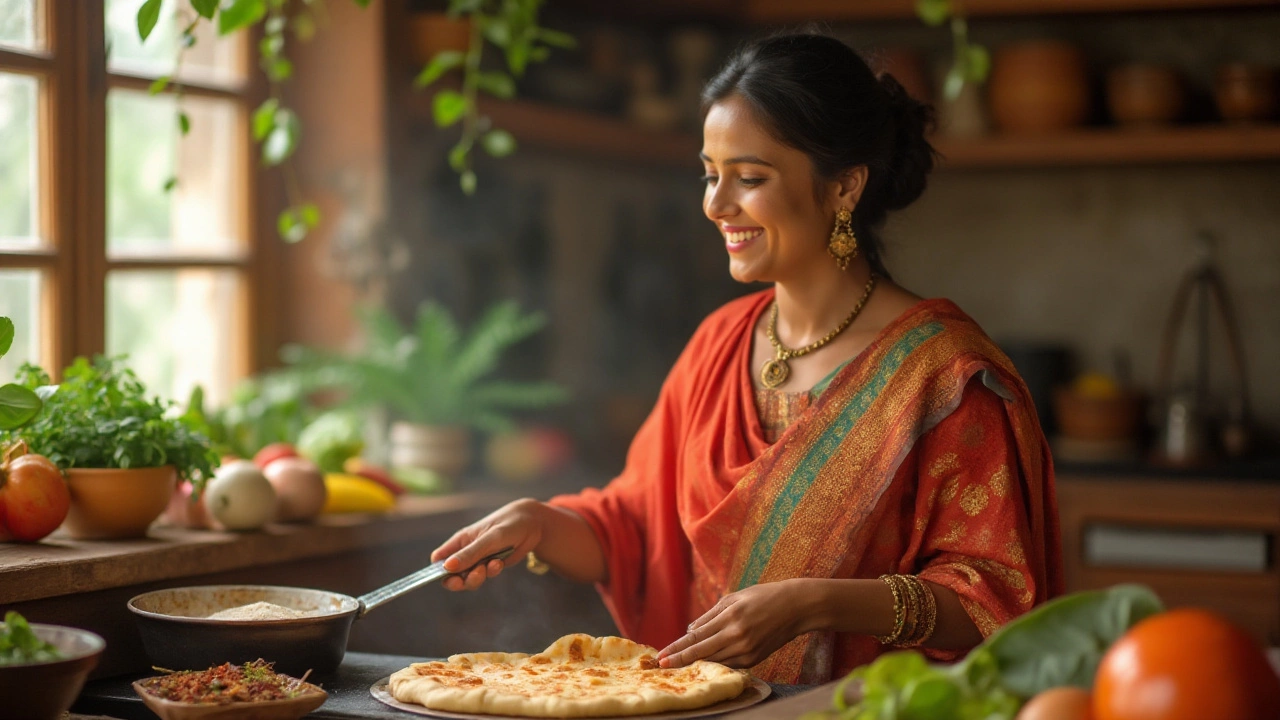22 Dec 2024
- 0 Comments
Naan is a delightful staple in Indian cuisine, often found accompanying curries and gravies with its soft, pillowy texture and satisfying taste. But if you're watching your waistline, you might wonder if this beloved bread can fit into your dietary plans. Balancing flavor and health is key, and it's possible to enjoy naan while still keeping aligned with your weight loss goals.
In this article, we'll explore the nutritional profile of naan and provide insights into how it can be part of a mindful eating strategy. From selecting healthier preparations to innovative twists, you'll find ways to savor naan without guilt. Let's embark on a delicious journey to understand how naan can be both a treat and a health-conscious choice.
- What Makes Naan Special?
- Nutritional Content of Naan
- Naan in a Balanced Diet
- Healthier Versions of Naan
- Tips for Including Naan in Weight Loss
- Creative Alternatives to Traditional Naan
What Makes Naan Special?
Naan is more than just a piece of bread to many; it's an integral part of cultural and culinary traditions that span centuries. Originating from India, this bread is unique due to its cooking method and its ability to complement a vast range of dishes. The traditional naan is prepared in a tandoor, a clay oven that gives it a distinct smoky flavor and a slightly charred exterior, while maintaining a soft, chewy interior. This preparation style makes naan a standout when it comes to bread, providing a texture and taste profile that’s difficult to replicate with conventional baking methods.
But that isn't the only thing that sets naan apart. Its basic ingredients—flour, water, yogurt, and sometimes milk or ghee (clarified butter)—combine to create a dough that's both pliable and rich. The addition of yogurt and ghee not only enhances the softness but also adds subtle flavors that transform the bread into a delightful experience. Some variations also incorporate garlic, spices, or seeds like nigella, elevating the naan into a versatile canvas for flavors. Each region in India has its take, with some opting for naan stuffed with spiced potatoes, paneer, or meats, making it not just an accompaniment but a dish unto itself.
The popularity of naan has spread globally, establishing it as a beloved accompaniment in many international dishes. In restaurants around the world, naan is served with a variety of Indian food and curries, cherished not just for its taste but for its ability to scoop up rich, flavorful dishes with a satisfying heft. As one food critic elegantly put it, "Naan is the kind of bread that acts as a spoon, a plate, and a companion all rolled into one"
(Source: The Global Culinary Journal).This versatility is an essential part of naan's charm—it fits seamlessly into daily meals while also being capable of standing on its own in terms of flavor and presence.
Interestingly, naan has also evolved to suit various dietary needs, with whole wheat versions becoming more prevalent as people seek healthier alternatives. This adaptability has allowed naan to maintain its status as a favorite not just in traditional Indian settings but in kitchens worldwide where home chefs experiment with global flavors. A testament to naan’s adaptability and enduring appeal is its inclusion in modern fusion recipes, where it dresses sandwiches, acts as a flatbread for pizzas, or is served as crispy naan crackers.
Understanding what makes naan special is about appreciating its multifaceted nature—its rich history, its culinary adaptability, and its communal importance. Whether enjoyed in its traditional form alongside curry or reimagined in contemporary dishes, naan remains a heartwarming favorite for many. It carries with it stories and flavors of a culture that values food as an art and a shared experience.
Nutritional Content of Naan
When it comes to enjoying naan, understanding its nutritional profile can help you make informed decisions, especially if you're aiming for weight loss or a balanced diet. Traditionally, naan is made from white flour, which isn't always the most health-friendly choice, particularly for those watching their carb intake. Typically, a piece of naan contains about 260 calories. For individuals wanting to know if naan fits into a calorie-conscious diet, these numbers are essential. Alongside calories, a standard portion of naan provides roughly 5 grams of protein and 1.5 grams of dietary fiber. However, the fiber content is relatively less compared to whole grain breads, as naan is often prepared with refined flour.
Where naan becomes a concern for health-conscious eaters is its high carbohydrate content—each piece has about 40 grams of carbohydrates. Given that carbohydrates should ideally be complex and slow-releasing sugars, naan doesn't always tick the health box. As delicious as it is, indulging too freely in naan can lead to unexpected calorie surpluses if not monitored properly. Moreover, it’s also important to note the presence of fats, much of which come from butter or ghee brushed on its hot, flaky surface, adding richness but also upping the saturated fat content significantly.
"Naan can unquestionably be enjoyed as a part of a healthy diet if consumed mindfully," says Dr. Rao, a nutrition expert. "Opting for whole wheat or multigrain variants can significantly increase the fiber content, enhancing its nutritional value," he suggests.Another point of consideration is the sodium content in naan, which can be notably high due to the salt added for flavor. This is particularly concerning for those who need to manage their sodium intake for health reasons, such as issues related to blood pressure. Understanding these nutritional facts allows you to think about portion control and frequency of indulgence. While naan might not align perfectly with nutritional tenets of modern diets, enjoying it sparingly or in a healthier version can be gratifying without sabotaging dietary objectives.
Below is a simple breakdown of the nutritional content in one average-sized naan:
| Component | Amount per Naan |
|---|---|
| Calories | 260 kcal |
| Protein | 5 g |
| Carbohydrates | 40 g |
| Fiber | 1.5 g |
| Fat | 6 g |
| Sodium | 400 mg |
Both nutritionists and food enthusiasts propose slight alterations to traditional naan recipes which can help minimize calorie intake without compromising its essence. Seeking out naan made from whole grain flour or those enriched with grains and seeds can help enhance not just flavor, but also health return. While nutrient-rich versions might vary in taste, these can equally satisfy a craving while supporting healthier eating habits. By balancing the texture and taste of your naan, you can enjoy this beloved Indian food while staying true to your dietary aspirations.

Naan in a Balanced Diet
When it comes to integrating naan into a balanced diet, the key lies in moderation and making mindful choices about the portion size. Naan, traditionally made with refined flour, is known for its exquisite taste and comforting texture. However, it's important to recognize that refined flour can lead to quick spikes in blood sugar, making it less than ideal for those pursuing a weight loss plan if consumed in large quantities. A balanced diet calls for careful consideration of how often and how much naan one might indulge in each week. In order to enjoy naan without derailing your health goals, aim to balance it with nutrient-dense foods like vegetables, lean proteins, and legumes that offer satiety and nutritional benefits.
Another aspect to consider is the ingredients used in traditional naan preparations. Most recipes call for added fats like ghee or butter, and while these contribute to the naan's delicious flavor, they also increase its calorie content. For those looking to include naan in their diet, seeking out or making lighter versions by reducing the amount of these fatty ingredients can be an effective way to cut down on calories. Some even opt for whole wheat naan as an alternative, which offers more fiber and a lower glycemic index, helping to maintain blood sugar levels more steadily. As noted nutritionist Rujuta Diwekar often says, "It's not the food, but the context in which you eat that makes a difference." This highlights the significance of overall dietary patterns rather than singling out one food item.
When constructing meals, think about how naan can be part of a diverse plate. A balanced meal might include a small piece of naan served alongside a generous portion of mixed greens, a serving of dal, and a grilled piece of chicken or paneer. This approach not only adds variety to the meal but also ensures that you're getting a wide range of nutrients while savoring your favorite bread. By pairing naan with protein and fiber-rich foods, you can enhance the satiating quality of your meal, which is crucial in a balanced diet. After all, achieving weight loss isn't just about cutting out foods, but rather making informed choices that nourish both the body and soul.
For those who enjoy variety, experimenting with naan recipes at home can be both fun and rewarding. Introducing ingredients like quinoa flour or adding seeds such as flax or chia can improve the nutritional profile, making naan a more wholesome part of your diet. Creating naan with a yogurt-based dough can also introduce a dose of probiotics, which are beneficial for gut health. While traditional tandoor ovens give naan its signature flavor, using a cast-iron skillet or grill at home can yield delightful results as well. By taking control of the ingredients and methods, you have the power to transform naan from an occasional indulgence to a regular, healthful part of your diet.
Healthier Versions of Naan
When it comes to enjoying naan while on a weight loss journey, opting for healthier versions is crucial. Traditional naan is typically made with refined white flour, which, while delicious, lacks the nutritional benefits of whole grains. One way to make naan healthier is to use whole wheat flour or a mix of different whole grain flours. This simple swap increases the fiber content, which is beneficial for digestion and provides a feeling of fullness, helping to curb overeating.
In addition, incorporating ingredients like yogurt or almond milk instead of heavy cream can cut down on calories and saturated fat. Another innovative approach is to add minced vegetables like spinach or carrots into the dough. Not only does this enhance the nutritional profile by adding vitamins and minerals, but it also brings a vibrant color and subtle taste to your naan. Baking the naan instead of cooking it in a tandoor or frying reduces the amount of oil or butter required, making it lighter and less calorie-dense.
Don't underestimate the power of spices and herbs to boost the health benefits and flavors of naan. Adding garlic, cumin seeds, or even fresh herbs like coriander directly into the dough can transform naan into a delicious and aromatic delight without the need for excessive fats. A sprinkle of chia or flaxseeds on top before baking can also add a health-conscious crunch and a dose of omega-3s.
According to the Harvard School of Public Health, swapping refined grains for whole grains can lead to a healthier and longer life, and these changes are easy to incorporate into traditional recipes like naan.
For those seeking gluten-free options, using alternative flours such as chickpea flour or almond flour can create a deliciously different naan experience. These variations maintain the beloved texture and taste while meeting specific dietary needs. By being adventurous with ingredients, one can enjoy Indian food without compromising on health goals.
Undoubtedly, making these modifications may require a bit of experimentation in the kitchen. However, the result is a bespoke naan that aligns with your dietary preferences and nutritional objectives. Embrace these changes, and you'll find that your favorite Indian food can still have a place on your dinner table, satisfying both your palate and your health aspirations.

Tips for Including Naan in Weight Loss
Incorporating naan into a weight loss plan might seem like a stretch, given its reputation for being a carb-rich indulgence, but with the right approach, it can certainly be done. The key lies in portion control and choosing nutrient-rich accompaniments. Start by limiting the serving size to half or even a quarter of a naan to manage calorie intake. Consider pairing it with high-protein foods like grilled chicken or tofu, which help to satisfy hunger without drastic calorie increases, thus maintaining your daily target. Keep your eyes on ingredient quality too; opt for whole grain or whole wheat naan to add fiber, which aids digestion and keeps you feeling fuller longer.
Exploring healthier cooking methods can also play a significant role. Traditional naan is often made with ghee or butter, adding extra calories, but there's room for healthier cooking techniques. Try cooking naan on a non-stick pan and using minimal oil, or opt for dry baking methods. The flavor can be creatively enhanced with herbs and spices, which adds zest without adding calories. Consider trying homemade naan versions that allow more control over ingredients, especially salt and fat content, to cater efficiently to health goals.
Mindful eating habits extend beyond the kitchen as well. Pay attention to what you're eating and how much of it – learning to savor each bite without distractions can significantly cut down on unnecessary consumption. Acknowledge your hunger cues and eat when you are truly hungry, not just from habit or boredom. As quoted by nutrition expert Rujuta Diwekar, "Your body knows best, it's tuned in, in ways you and I can't understand, so tune in, listen to your body." Embracing this mindset can make working naan into your diet a more gratifying experience.
Incorporate naan wisely into your meal planning by selecting times when its inclusion can add nutritional benefit, like post-workout meals. After physical activity, your body is primed to use carbohydrates for muscle replenishment and energy recovery. Additionally, realize the importance of balance and variety – don't let naan become a daily habit; replace it occasionally with other healthy snacks and options to keep things interesting and balanced. A diversified diet not only supports wellness but also ensures sustained weight loss success.
Nutritional customization and experimentation pave the path to a sustainable diet. By understanding and applying these tips, naan need not be off-limits. Balancing flavors, nutrition, and satisfaction is an art, and with some mindfulness, it's possible to enjoy this delightful Indian food without straying from weight loss objectives.
Creative Alternatives to Traditional Naan
When it comes to enjoying the delectable flavors of Indian cuisine while also being mindful of diet goals, exploring creative alternatives can be a game-changer. Traditional naan is beloved for its softness and chewiness, yet for those who are calorie-conscious, there are plenty of innovative ways to enjoy this classic bread without overindulging. Let's dive into some exciting alternatives that allow you to relish the taste without worrying too much about the waistline.
One of the first substitutes rising in popularity is using whole wheat flour instead of refined flour, which offers a boost in fiber and essential nutrients missing from the white flour versions. Whole wheat naan retains a similar texture but contributes more to your health goals, helping to keep you fuller for longer periods. Some bakers infuse their dough with flaxseeds or chia seeds, providing a delightful nutty flavor while adding beneficial omega-3 fatty acids. Including seeds not only enhances the nutritional profile but provides a nice texture contrast that many find appealing.
For a gluten-free twist, cauliflower naan is a trending alternative. Using cauliflower rice as a base mixed with a bit of chickpea flour can yield a surprisingly tasty and hearty bread. It holds together beautifully after baking, proving cauliflower’s versatility in the kitchen. Not only is it light on calories, but it also brings antioxidants to the table, making it a fantastic choice for those managing weight. Although this method requires a bit of experimentation to perfect, many swear by the rewarding taste and texture.
Another excellent alternative is utilizing almond or coconut flour to bring sweetness and nuttiness to your weight loss routine. These flours maintain a low-glycemic index, making them excellent options if you are looking to stabilize your blood sugar levels. Adding spices such as cumin, coriander, and black sesame seeds can enhance the flavors substantially. Baking, rather than frying or griddling, is often preferred with these ingredients to bring out their natural aromas while keeping the health factor in check.
“Embracing diversity in grains and ingredients allows anyone to enjoy their favorite foods without losing out on health advantages,” noted Sneha Kapoor, a prominent nutritionist in the field of culinary health.
For those who enjoy a playful culinary approach, incorporating pumpkin puree or beetroot into the dough not only brings vibrant colors to the plate but also offers the antioxidant benefits of these vegetables. This teases the eye and provides a wider array of vitamins and minerals that are crucial for maintaining overall well-being while pursuing a healthy diet. Generously seasoning the dough with herbs like cilantro and mint can marry well with the earthy undertones, delivering an aromatic experience.
Naan can remain an enjoyable part of your meals by adopting some of these suggestions. Whether you prefer whole grain, gluten-free, or vegetable-based variations, the key lies in balancing flavors and nutrients in a way that satisfies both the tongue and the tummy. Creative cooking not only transforms this humble bread into a diet-friendly option but reinvigorates your entire approach to Indian food.
